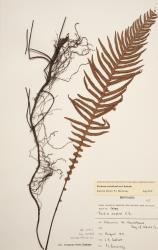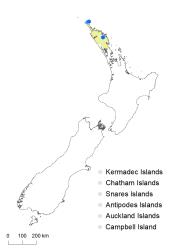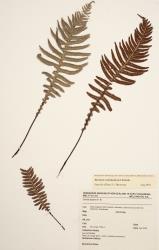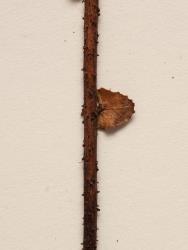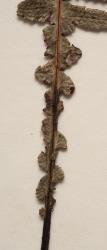- ≡ Doodia aspera R.Br., Prodr. Fl. Nov. Holland. 151 (1810)
- ≡ Woodwardia aspera (R.Br.) Fée, Mém. Foug., 5. Gen. Filic. 207 (1852)
Blechnum neohollandicum is very similar to B. parrisiae and distinguished primarily by its pinnae, which are all, except sometimes the basal pair, adnate to the rachis. There are several pairs of markedly reduced pinnae at the base of the lamina, whereas in B. parrisiae the pinnae reduce gradually to the base. The stipe, rachis and pinna costae in B. neohollandicum lack hairs but bear tubercules, whereas in B. parrisiae the rachis and costae are minutely hairy but lack tubercles. The rhizomes are long-creeping or stoloniferous.
North Island: Northland.
Altitudinal range: 20–40 m.
Blechnum neohollandicum is probably no longer extant in New Zealand. It has been collected from Waiomio, near Kawakawa in Northland, where it is now extinct. Its former presence is also inferred from an extensive hybrid population at Tom Bowling Bay believed to involve B. neohollandicum and B. parrisiae (de Lange et al. 2004). Fronds collected from Martin’s Bay, Warkworth (AK 141648–141649, 212063), with the general appearance of B. neohollandicum but with pubescent rachises, are possibly of hybrid origin. Another collection from Te Kaha Rocks north of Raglan Harbour (AK 351063) is more equivocal. The frond shape and glabrous rachises suggest B. neohollandicum, but the sparse tubercles on the abaxial frond surface suggest a possible hybrid with B. parrisiae. Both collections require further investigation.
Also Australia (Queensland, New South Wales, Victoria).
Blechnum neohollandicum was recorded growing under mānuka scrub at Waiomio and Raglan Harbour, and the hybrid population at Tom Bowling Bay occurs under dry mānuka and kānuka scrub.
Blechnum neohollandicum was given a conservation status of Vagrant by de Lange et al. (2018).
There is evidence for hybridisation between B. neohollandicum and B. parrisiae. Plants from the population at Tom Bowlng Bay were reported to have aborted spores, and to have 2n = 96, in contrast to those from Waiomio, which had 2n = 64 (de Lange et al. 2004). Based on morphology and the reported chromosome number of n = 64 in B. parrisiae (Brownlie 1961), de Lange et al. (2004) suggested that the plants at Tom Bowling Bay were hybrids between B. neohollandicum and B. parrisiae, rather than B. neohollandicum, as had previously been thought (Parris 1972).
2n = 64 (de Lange et al. 2004).
Doodia aspera was not recognised in the New Zealand flora by Allan (1961), and only first accepted by Parris (1972). When treated in Blechnum, it requires the new name B. neohollandicum (Christenhusz et al. 2011).



